When purchasing speakers, the subwoofer is the component that takes your system from average to outstanding. In the home, it can give you the cinema experience when watching a movie or allow bone-crunching bass in your record collection.
When used for live sound setups, subwoofers deliver the extra punch needed so that your audience can enjoy the performance the way it is supposed to.
Choosing the best subwoofer is a challenging task. There are many models and designs on the market, and any advice given often comes down to personal preference. We discuss the types of subwoofers so that you can make an informed decision.
What Defines a Subwoofer?
The subwoofer is the part of a speaker set that produces the lowest frequency ranges. In essence, it provides bass and the deepest of frequencies in your sound system. In a home theater sound system, it is the first component of a 5.1 surround sound system.
Subwoofers come in a couple of configurations, active and passive; let’s explain both.
Passive Subwoofer
Passive subwoofers are powered by an external amplifier. The amplifier must-have enough power to sustain bass effects through your subwoofer speaker. The size of your speaker will determine the amplifier required.
Active Subwoofer
An active unit has the amplifier built into it. This means it will require its own AC power source. In sound systems for live performances as well as for home theatre set up, it is likely that the subwoofer will be active.
What is a Crossover?
When purchasing a subwoofer, you may read about a component called the crossover. The crossover is not concerned with speakers and sound distribution, but it is the circuit that decides what frequencies are routed to the subwoofer. Typically, frequencies between 80 to 100hz are sent to the subwoofers, with higher frequencies being sent to the rest of the speaker system.
Types of Subwoofers
Ported Subwoofers
When choosing a subwoofer, you may see many advertised as ported. This means that they have an extra hole, or port, that allows air to escape, often through a tube. It can really boost the bass level of the subwoofer.
The reason for this is that the extra escaping air also contains bass frequencies that would not often have an escape route. As such, you may hear these speakers referred to as ‘bass reflex’ speakers. They give a thick, rich bass sound.
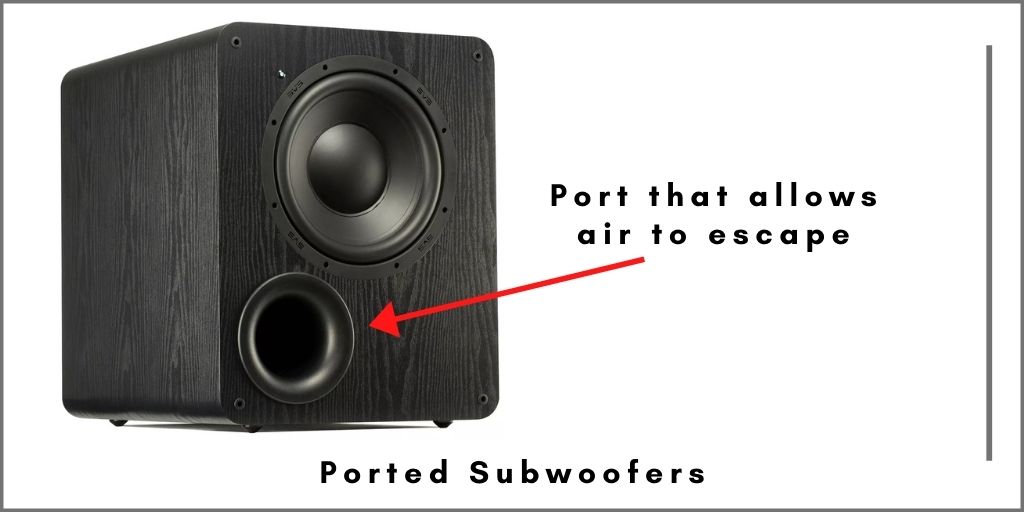
Sealed Cabinet
A unit without a port or passive radiator is a sealed cabinet. In this model, the bass only has one route to leave the cabinet. What may be lost in depth is compensated for in a more well-rounded sound, with fewer peaks and booms.
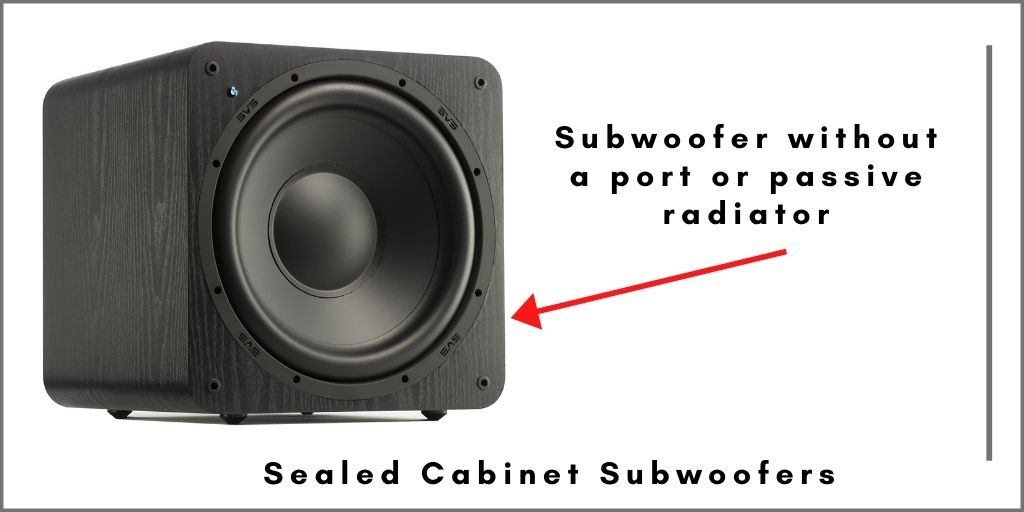
Passive Radiator
Some subwoofers take the idea of a ported speaker one step further with a passive radiator design. They replace the port with two passive radiators that are not wired to the amp. Their movement allows sound to escape the speaker in a similar way to a port but with a much greater range of frequencies.
This type of design allows for a big, wide-ranging sound in some fairly small speakers sets. They are great for people who want car audio with huge bass frequencies.
Subwoofers with passive radiators are very common in most Bluetooth speakers. By adding a passive radiator, you could get decent low-frequency rage even with small woofers, making it practical to design small cabinets that deliver big sound.
Front and Down Firing Types of Subwoofers
Front and down-firing refer to the placement of the internal speakers within the subwoofer unit. Front-firing models will often have a speaker pointed forward. Sound will radiate to the front and sides of the unit.
Downward facing points the sound toward the front and ground. This is useful if speakers are raised on stands or placed on shelving.
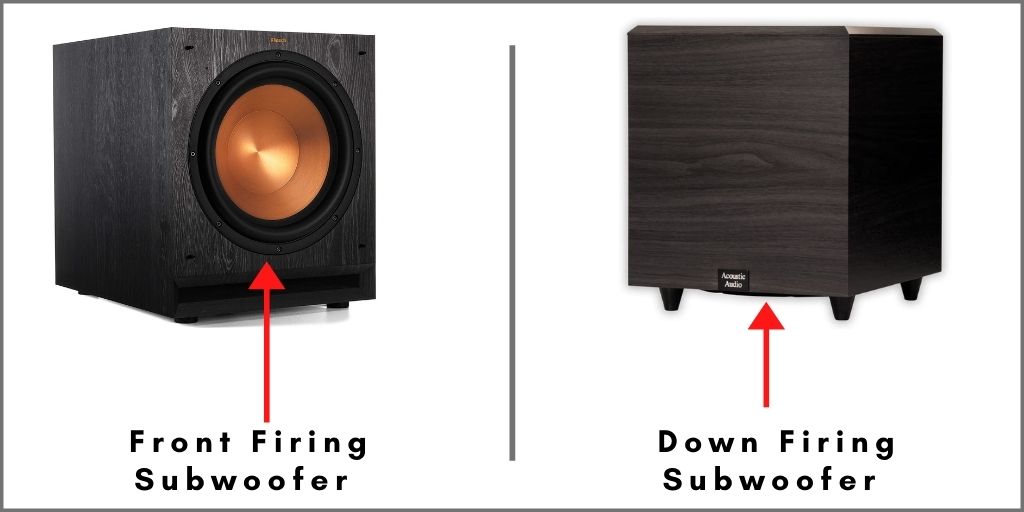
Bandpass Subwoofers
These subwoofers are a more complex design and allow for clean, natural bass output within given frequency ranges. They allow you to specify the levels of bass you want to come through the speakers with great precision.
Bandpass speakers have two chambers that are separated. Usually, only one part of the divide will have a port that releases any radiation from the front cone.
This type of design is commonly used in professional live sound equipment such as line array systems used in large arenas. It is also frequently used in subwoofers cabinets designed for car audio.
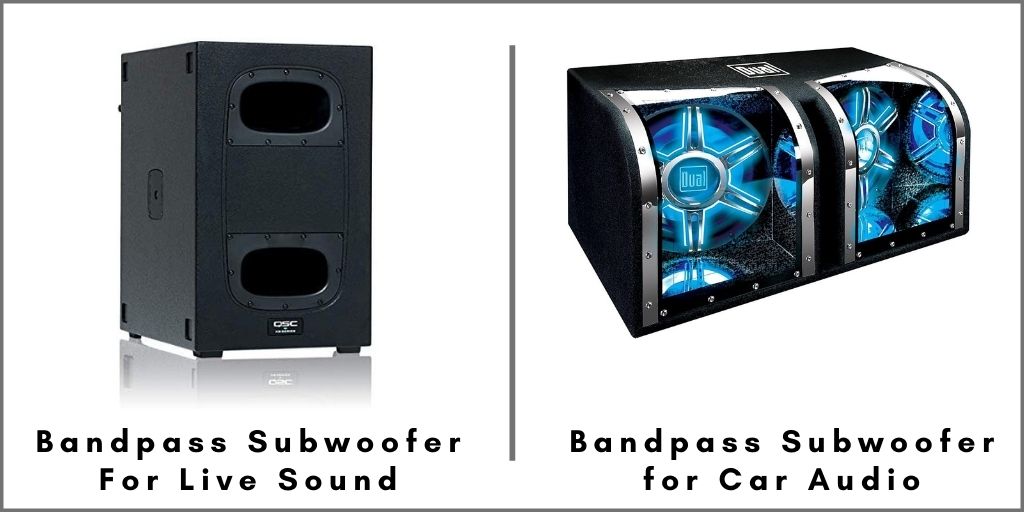
Horn Loaded Subwoofer
Horn-loaded speakers tend to sound louder than their counterparts. Their sound is also more directional in the higher frequency bands. They do this by focusing sound that would otherwise have leaked and spread out in various directions, and channeling it through a longhorn speaker.
For this reason, they are typically used in large venues where sound needs to go further and aim more precisely. They can often be found in quite small, compact sizes despite the range of equipment and sophistication required within.
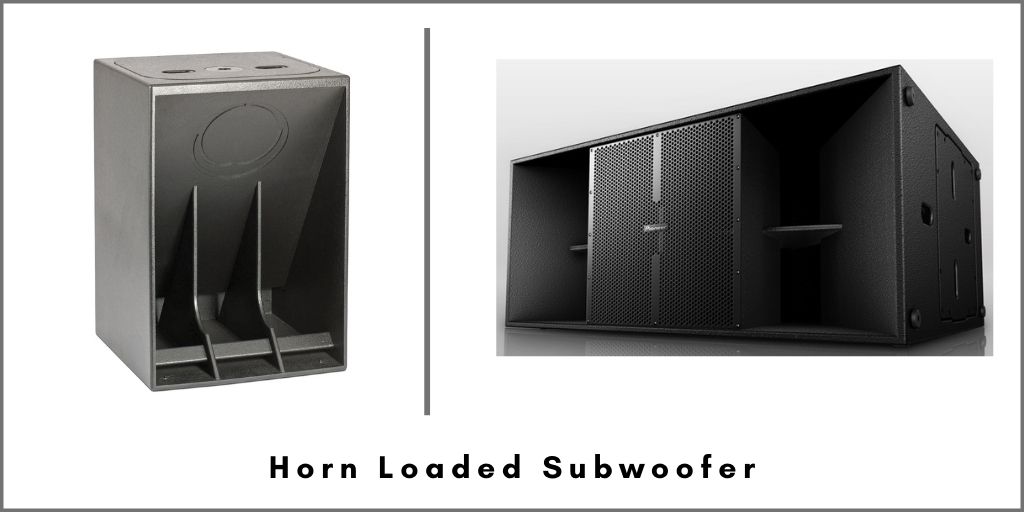
Choosing a Car Subwoofer
As well as the variations of subwoofers, special considerations must be given if you are choosing types of subwoofers for cars. Cars are small areas with strange internal shapes and have the addition of engine and road noise to contend with. Consider the placement and type of subwoofer before making a purchase.
For this reason, powered active units tend to work better in automobiles. This is because they allow more control and power, essential when on the road.
Car subwoofers tend to come in 8 and 10-inch models. A bigger speaker is not necessarily better, as it will distort in the shell of a small car. 10-inch subwoofers should be reserved for larger, family cars.
Placement of Car Subwoofers
Again, this comes down to the size and model of the car. The two options are generally under-seat models and trunk placements. Both have some individual traits.
Placing the subwoofer under a seat will allow you more control and clarity of sound.
However, for anyone with passengers or a child in the back, bass pumping under your seat can be a little annoying. The trunk negates this, but you may lose some of the clarity if you are looking to purchase speakers that are clear.
Combining it with Other Speakers
Once you have the types of subwoofers narrowed down, all you need to do is combine it with the other parts of your sound system. If you need more advice and help with choosing the correct system, visit our blog at Virtuoso Central. We have lots of articles on everything you will need to purchase, pick, and place your ideal speaker set up.